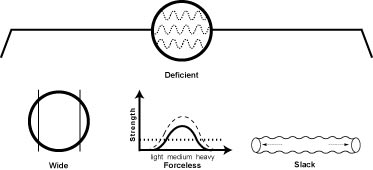The Deficient, Empty, Vacuous Pulse (Xu Mai)

Deficient Pulse (?? Xu Mai, empty, vacuous)
Key points: forceless at all three levels, can be wide.
Indications: (floating) qi deficiency: perhaps related to end stage yang deficiency.
(Submerged) Internal deficiency: yang can’t rise.
(Choppy) blood stagnation due to blood deficiency: deficient fluid to create flow.
(Rapid) Yin deficiency: relative hyperactivity of yang causes width.
(Slow) Yang deficiency: yang unable to warm heart, move blood.
Explanation: just about anything can be deficient giving rise to the deficiency pulse. In the case of a pulse that is palpable on all three levels, but favors the superficial level, this suggests that the qi is floating as is found in some end-stage conditions. One should not however make a statement that the patient is about to expire based solely on a floating deficient pulse. That would be irresponsible and likely inaccurate.
As for the deficient pulse that is more deep than anything, this is essentially the same pulse as the submerged pulse. A lack of yang qi undermines the yang qi’s lifting and strength in the pulse.
A pulse that is forceless on all three levels, but also lacking a smooth flow as we see in the choppy pulse suggests blood stagnation due to a lack of adequate amounts of blood, another global deficiency.
The pulse that is slow and deficient is much like the submerged pulse, the yang qi that is needed to lift and power the pulse is lacking such that the pulse rate slows down.

The Deficient Pulse

Comparison of Scattered, Faint, and Deficient Pulses
Next: the excessive, full, or replete pulse.
 Last modified: August 1, 2009
Last modified: August 1, 2009  Tags: Diagnosis, Palpation · Posted in: Pulse Class, Pulse-Palpation
Tags: Diagnosis, Palpation · Posted in: Pulse Class, Pulse-Palpation
